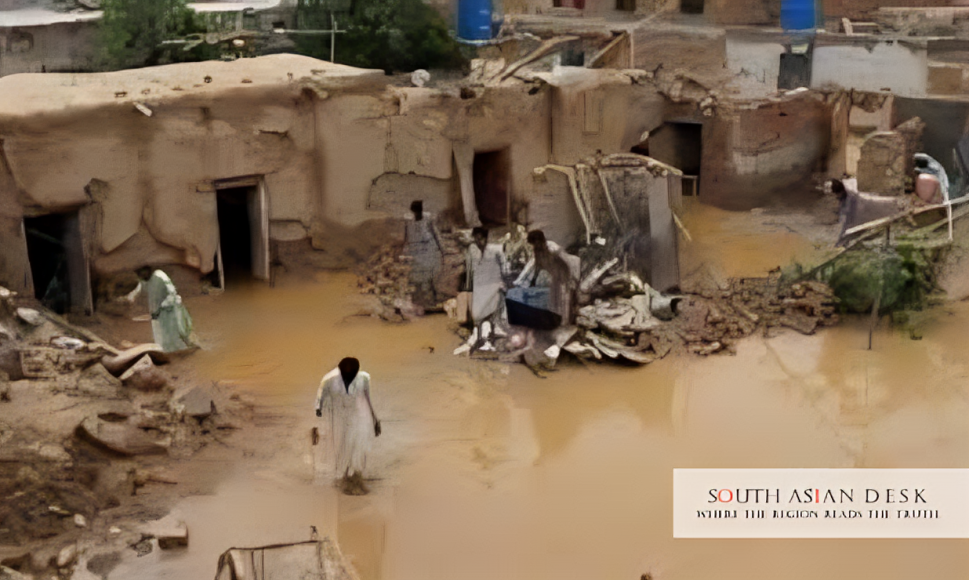Over 3,000 schools across Punjab, are covered in Pakistan floods damage caused by breaches in the Sutlej River embankment, affecting districts including Multan, Lodhran, and Bahawalpur since early September 2025, with the provincial government pledging rehabilitation within three months to resume classes for displaced students.
The Punjab Pakistan floods damage underscores the fragility of educational systems in South Asia, where recurrent natural disasters threaten to widen inequality gaps and hinder human development in flood-vulnerable agrarian economies.
Extent of Punjab Schools Damaged in Floods
The Punjab Pakistan floods damage has left more than 3,000 educational institutions partially or fully submerged, marking one of the most significant disruptions to schooling in the province’s recent history. According to Punjab Minister for School Education Rana Sikandar Hayat, the School Education Department was already grappling with limited facilities prior to the disaster, and the floods have exacerbated this crisis by rendering thousands of schools unusable.
Floodwaters, reaching depths of 8 to 10 feet in affected villages, have inundated classrooms, destroyed textbooks, and compromised school buildings in low-lying areas. Districts such as Multan, Lodhran, and Bahawalpur bore the brunt, with specific locales like Jalalpur Pirwala, Noraja Bhutta, and Basti Lang reporting widespread submersion. The catastrophe stems from three breaches at the Noraja Bhutta embankment along the Sutlej River, leading to catastrophic ponding that persisted for over a week by Friday, September 26, 2025.
Residents in these areas have highlighted how inadequate drainage infrastructure, including insufficient culverts under nearby motorways, trapped the water and intensified the Punjab schools damaged floods scenario. This has not only halted academic activities but also forced the relocation of students, with many now attending classes in makeshift arrangements or missing out entirely.
Government Assessment of Flood Impacts
Preliminary assessments by the provincial authorities indicate that the Punjab Pakistan floods damage extends beyond mere submersion, with structural collapses reported in numerous facilities. The minister noted that detailed evaluations are underway to quantify the full scope, including damage to furniture, electrical systems, and boundary walls. According to the Ministry of School Education, Punjab, the total affected student population exceeds tens of thousands, amplifying concerns over learning loss in a region where school enrolment rates hover around 70 per cent.
Broader Ramifications of Punjab Pakistan Floods Damage
Beyond the immediate educational fallout from the Punjab schools damaged floods, the Punjab Pakistan floods damage has triggered a cascade of secondary challenges. In the hardest-hit villages, such as Kotla Chakar and Bahadurpur, approximately 70 per cent of homes have collapsed under the weight of prolonged water exposure, displacing families and straining local resources. Stagnant waters have turned discoloured, fostering the outbreak of waterborne diseases and signalling an emerging health crisis.
The economic toll is equally stark, with agricultural lands submerged and livestock losses mounting, further burdening households reliant on farming. For children, the interruption in schooling compounds these hardships, potentially leading to higher dropout rates and long-term socioeconomic setbacks. The floods, which began intensifying in late August 2025 due to heavy monsoon rains, have affected over 1 million evacuees province-wide, according to relief agencies.
Government Response to Punjab Schools Damaged Floods
In response to the Punjab Pakistan floods damage, the provincial administration has outlined a multi-pronged strategy to restore normalcy. Three-shift systems have been introduced in operational schools to accommodate students from inundated facilities, while private buildings are being rented as temporary venues. Tent schools are slated for erection in the most affected zones to prevent prolonged educational gaps.
Semester fees for students from flood-hit areas have been waived, and scholarships announced to ease financial pressures on families. Punjab Education Minister Rana Sikandar Hayat stated: “The department is now confronted with the challenge of rehabilitating these schools… Full rehabilitation may take three months. To support families, the government has waived semester fees for flood-affected students and announced scholarships.”
Collaboration with international partners, including Unicef, is anticipated to bolster these efforts. Meanwhile, the National Highway Authority (NHA) has refuted claims of motorway interference, with General Manager Kashif Nawaz affirming: “There was no question of breaching the motorway and that water was passing through culverts underneath. Efforts were being made to secure the motorway by placing stones around vulnerable points.”
Background
The 2025 floods in Pakistan represent a continuation of the country’s vulnerability to climate-exacerbated weather events, following the devastating 2022 deluges that claimed over 1,700 lives nationwide. This year’s monsoon, unusually intense in Punjab, has led to riverine overflows and urban ponding, with the Sutlej River’s breaches amplifying the Punjab Pakistan floods damage. Official data from the Punjab Disaster Management Authority highlights that such incidents disproportionately impact rural educational infrastructure, where schools often double as community shelters.
What’s Next for Recovery
As cleanup operations progress, the focus shifts to rapid reconstruction, with tenders for repair works expected within weeks. Monitoring for disease outbreaks remains critical, alongside sustained relief distributions. The government aims to integrate climate-resilient designs into rebuilt schools to mitigate future Punjab schools damaged floods risks.
In the wake of this calamity, addressing the Punjab Pakistan floods damage through resilient infrastructure will be essential to safeguarding the province’s educational landscape and ensuring no child is left behind.
Published in SouthAsianDesk, September 26th, 2025
Follow SouthAsianDesk on X, Instagram, and Facebook for insights on business and current affairs from across South Asia.






